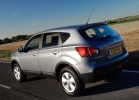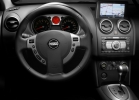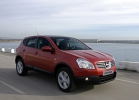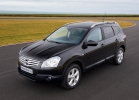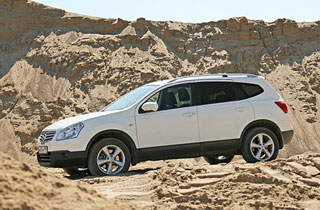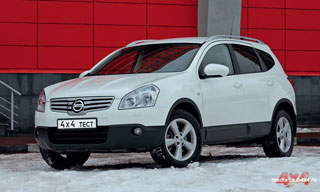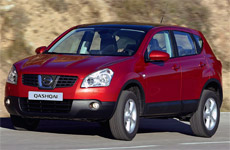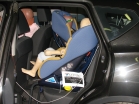Test drive Nissan Qashqai 2007 - 2010 SUV
City wanderer
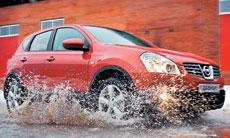 Nissan Qashqai belongs to the new generation of crossovers: it combines the comfort and practicality of the passenger machine with the characteristics of the SUV.
Nissan Qashqai belongs to the new generation of crossovers: it combines the comfort and practicality of the passenger machine with the characteristics of the SUV. Qashqai is similar to dimensions with cars C class C and a little more compact than typical SUVs. Its unusual style is due to a successful combination of smooth lines of the passenger car and the powerful spirit of the SUV.
The model received its name in honor of the Kash-Qay nomadic tribe living in the mountains in the south-west of Iran. Although the initial design concept was born in Japan, most of the work on creating the appearance and design of Qashqai was done in Europe, and in particular in the European Nissan Design Center in London and the European Technical Center, NISSAN (NTCE) in Cranfield, Great Britain. The crossover is collected on Nissan in Sanderland, which was marked by several awards in the northeast of England.
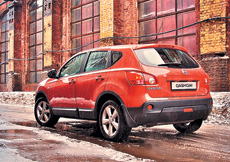 The dynamic appearance of the car is complemented by an asymmetric interior: a pronounced cockpit that provides the driver with convenient access to the governing bodies, and the space of the passenger zone that has the space of the passenger zone. Due to the high landing, as well as a significant road clearance, there are sensations of safety and unlimited possibilities that are characteristic of driving in SUVs. However, the model has the dynamics and controllability of a passenger car.
The dynamic appearance of the car is complemented by an asymmetric interior: a pronounced cockpit that provides the driver with convenient access to the governing bodies, and the space of the passenger zone that has the space of the passenger zone. Due to the high landing, as well as a significant road clearance, there are sensations of safety and unlimited possibilities that are characteristic of driving in SUVs. However, the model has the dynamics and controllability of a passenger car. Qashqai is proposed in versions with front and all -wheel drive and equipped with gasoline engines of 1.6 and 2.0 liters. The machines supplied to Russia are equipped with five- and six-speed manual gearboxes and the unavailable CVT variator.
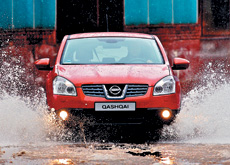 The gasoline engine of the basic configuration was originally created for Micra SR and Note models. A power unit with a block and a cylinder block from an aluminum alloy with a working volume of 1598 cubic meters. cm was finalized for a new car. The maximum power and torque brought to 115 hp. and 156 Nm, respectively: the increase reached 5 hp. and 7 Nm. The maximum speed was 175 km/h, acceleration to 100 km/h 12 s, fuel consumption in mixed mode of 6.7 liters per 100 km.
The gasoline engine of the basic configuration was originally created for Micra SR and Note models. A power unit with a block and a cylinder block from an aluminum alloy with a working volume of 1598 cubic meters. cm was finalized for a new car. The maximum power and torque brought to 115 hp. and 156 Nm, respectively: the increase reached 5 hp. and 7 Nm. The maximum speed was 175 km/h, acceleration to 100 km/h 12 s, fuel consumption in mixed mode of 6.7 liters per 100 km. The new 2-liter engine is also made of aluminum alloys, its power is 140 hp, and the maximum torque 196 Nm. Moreover, about 90% of the highest value of Nm are available from 2000 rpm. This unit is almost as compact as a 1.6-liter. In addition, its feature is a significant decrease in internal friction due to the special surfaces processing technique, usually used in the finalization of racing motors, but rarely used for serial production.
A two -liter gasoline engine is installed on versions with front or four -wheel drive and a six -speed manual gearbox or a unavailable variator (CVT) with the possibility of manual switching. The full -wheel drive version of the model has the following technical characteristics: maximum speed of 180 km/h, acceleration to 100 km/h 10.7 s, fuel consumption in a mixed cycle of 8.0 liters per 100 km.
The well-known electronic control system of all-wheel drive Nissan All-Mode, which was first used on the X-Trail model, is available on versions with 2-liter engines. Full -wheel drive provides stability on the road and increases safety and controllability under any weather conditions.
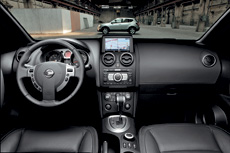 Carefully thought out Qashqai salon is functional. All main and auxiliary controls are concentrated around the driver, which is separated from passengers by an unusually high central console. In it, from the driver's side, there is a seizure for the parking brake lever, as well as two cup holders and a duffel box with a retractable armrest. In the center of the torpedo, under the protective visor, there is a dashboard and a route computer. The secondary controls are conveniently placed in the center of the toolbar, above the gear lever, under two ventilation holes. On the steering wheel, the audio control buttons are installed. The scale of the devices is lit using white LEDs, and for devices such as a route computer in the center of the toolbar, the windows button and the audio system control, saturated orange backlight was used.
Carefully thought out Qashqai salon is functional. All main and auxiliary controls are concentrated around the driver, which is separated from passengers by an unusually high central console. In it, from the driver's side, there is a seizure for the parking brake lever, as well as two cup holders and a duffel box with a retractable armrest. In the center of the torpedo, under the protective visor, there is a dashboard and a route computer. The secondary controls are conveniently placed in the center of the toolbar, above the gear lever, under two ventilation holes. On the steering wheel, the audio control buttons are installed. The scale of the devices is lit using white LEDs, and for devices such as a route computer in the center of the toolbar, the windows button and the audio system control, saturated orange backlight was used. The sports potential of the crossover is demonstrated by the front seats with developed side support. The rear sofa, folded in a ratio of 60/40, provides two passengers with maximum comfort, but in general the car is equipped with three -point seat belts for five people.
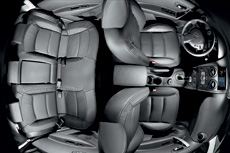 The trunk container is 410 liters. You can increase its volume to 1513 liters by transforming the rear seats: the chair pillow is fixed, and all that is required is to fold each part of the back in one time. Moreover, there is no need to first remove the headrests. After that, in the cargo ward, from the luggage door to the backs of the front seats, the floor becomes almost even.
The trunk container is 410 liters. You can increase its volume to 1513 liters by transforming the rear seats: the chair pillow is fixed, and all that is required is to fold each part of the back in one time. Moreover, there is no need to first remove the headrests. After that, in the cargo ward, from the luggage door to the backs of the front seats, the floor becomes almost even. Qashqai provides many additional compartments for storing small things. A huge glove box with a cooling function of 14 liters of cargo space is capable of accommodating 15 cans with drinks. There is a built-in glasses for glasses in the cabin, and both a half-liter bottle and A4 format folder will fit in each door pocket. Mesh pockets on the backs of the front seats contain A3 atlases. The central console provides a branch with a volume of 3.5 liters for eight CDs, under the front passenger seat there is a drawing tray with a volume of 4 liters.
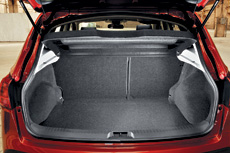 Another key advantage of the model is a high level of passive and active safety. A hard body that provides a maximum of passive protection is equipped with an ESP of the latest generation, TCS, EBD and ABS. The standard package of each version includes six airbags. The brake system was also finalized and equipped with a hydraulic compensation system (HFC) to create optimal brake force in case of reducing brake efficiency due to overheating.
Another key advantage of the model is a high level of passive and active safety. A hard body that provides a maximum of passive protection is equipped with an ESP of the latest generation, TCS, EBD and ABS. The standard package of each version includes six airbags. The brake system was also finalized and equipped with a hydraulic compensation system (HFC) to create optimal brake force in case of reducing brake efficiency due to overheating. A typical set of equipment for the basic version of Qashqai in the XE configuration contains ABS, an electronic brake force distribution system (EBD), auxiliary braking system (BAS), six airbags, electric mirrors, electric windows with all doors, an on -board computer, front armrest, adjustable, adjustable In height, a driver’s seat and 16-inch steel disks with caps, an audio system with control on the steering wheel and a loud function for a mobile phone through the Bluetooth connection, and the air conditioning system.
The SE and SE+ configuration additionally provide a two-zone climate control system, alloy wheels, rain sensors, electric power plants of lateral mirrors, a central armrest in the rear seat, door mirrors and handles painted in the color of the body, front fogging of the steering wheel, leather finish and adjustable lumbar support driver's seat.
As options, you can order chip key (Intelligent Key), electric drive of external mirrors, leather interior decoration, xenon headlights, a cruise control system, six discs for six discs, an ESP system, a rear view camera.
In Russia, the most affordable front-wheel drive Qashqai 1.6 XE configuration will cost the buyer 584,260 rubles, prices for cars with 2-liter engines start from 649,760 rubles. For the version with all leading wheels, you will have to pay at least 712,640 rubles.
Video test drives Nissan Qashqai 2007 - 2010
Video Crash tests Nissan Qashqai 2007 - 2010
Test drives Nissan Qashqai 2007 - 2010
Nissan Qashqai 2007 - 2010 crash test
Krassh Test: Detailed Information37%
Driver and passengers
18%
Pedestrians
40%
Children-passengers
Nissan Qashqai 2007 - 2010 malfunctions
Nissan Qashqai malfunctions: Detailed information| Qashqai 2007 - 2010 | |
|---|---|
| Engine |  |
| Transmission |  |
| Control system and suspension |  |
| Brake system |  |
| Air heating and air conditioning |  |
| Launch and charging system |  |
| Electric components and so on |  |
| Corrosion body stability |  |

